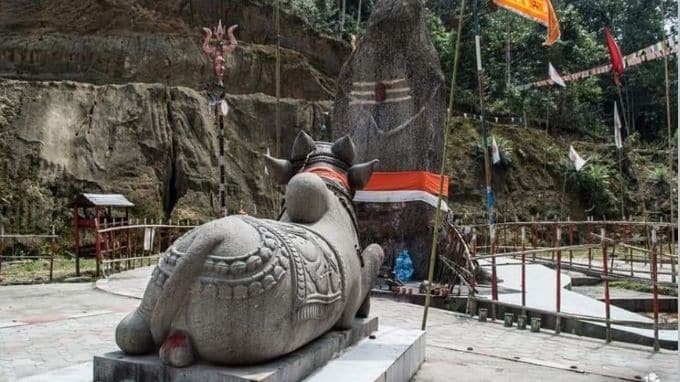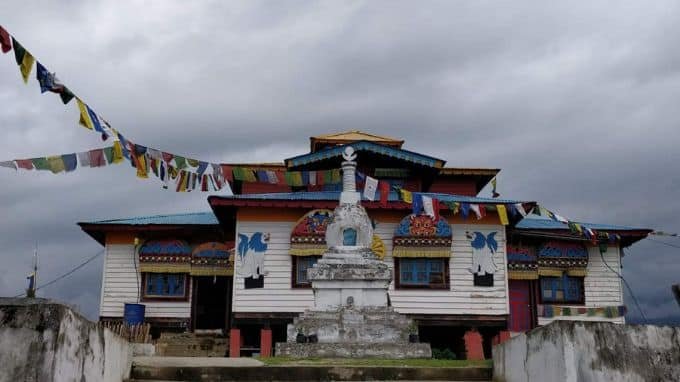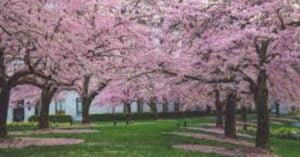When we think of Arunachal Pradesh, we think of the vast barren land of the Himalayas, snow-capped mountains, lakes and valleys. Arunachal Pradesh is not known for its history. But the tribes living in Arunachal Pradesh have a history that is as old as Vedic civilisation. This informative blog will explain all the heritage sites of Arunachal Pradesh with their brief history and travel guidelines.
The heritage sites of Arunachal Pradesh can be divided into three types: sites belonging to Hinduism, sites belonging to Theravada Buddhism and sites belonging to Mahayana Buddhism.
Heritage Sites of Hinduism
Arunachal Pradesh is primarily a tribal and Buddhist state and doesn’t have a dominant influence of Hinduism in its contemporary or indigenous cultures. The Hindus constitute a minority, accounting for 29.04% of the overall population. However, there are a few Hindu temples and heritage sites found in southern parts of Arunachal, close to Assam.
Parashuram Kund

Parshuram Kund is a Hindu pilgrimage site situated at Telu Shati/Tailung area of the Mishmi plateau in the lower reaches of the Lohit River. It is approximately 48 km via Tohangam from Tezu, the Headquarters of Lohit District in Arunachal Pradesh.
The site got its name from Lord Vishnu’s sixth incarnation- sage Parshuram. According to Hindu faith, the sage Parshuram, on the advice of some sages is said to have wandered all over the Himalayan range to atone for the sin of matricide initiated by his father. The axe that was stuck to his hand fell away at this site, cleaving the mountain that sprang the Brahmakund (watersource).
This popular site attracts pilgrims from all over the world. Over 70,000 devotees and sadhus take a holy dip in its water each year on the occasion of Makar Sankranti, in January. It is believed that taking a dip in the holy water of Parshuram Kund cleanses one of the sins.
Malinithan Temple Complex

Malinithan, situated near the Assam-Arunachal border (Likabali) in the West Siang district, has temple ruins of sculptural and architectural value. It is assumed to be built by one unknown Chutia king in the 13th-14th century. Stone sculptures of Hindu gods and goddesses such as Surya, Kartikam, Indra, Nandi bull, Raksah, and Ganesh, and animal motifs such as bull, lion, and elephant were discovered. According to archaeologists, Malinithan is a temple complex comprising as many as four temple bases. This heritage site can be considered the largest Hindu temple complex in Arunachal and can be accessed via Likabali-Silapathar route from Assam.
Some theorise that this was where Lord Krishna once stopped to rest and was offered flowers by Goddess Parvati (Malini) on his journey to Dwarka after marrying Rukmini. Many legends also associate this place with Kechai-Khaiti, a tribal goddess found among the Bodo-kachori groups or the Buddhist goddess Tara.
Interesting artefacts from Malinithan, such as sculptures recovered from the site, are displayed at the Jawaharlal Nehru Museum (Itanagar).
Bhismaknagar Fort
This brick fortress is believed to have been built by the Bhismaka, a legendary Chutiya king, who had a stronghold in the Sadiya region of present-day Assam and the foothills of Arunachal Pradesh between the 12th and 16th centuries CE. The fort is in ruined condition. However, many people visit Bhismaknagar to relive the legend associated with this fort.
Kardo Hill Temple

It is also known as Siddheshwar Nath Temple. Situated in the Ziro Valley, Kardo Hill Temple is known for its Shivalinga. The Shivalinga is basically a large rock that resembles a linga. It is one of the largest Shiva lingas in the world. The Shivalinga here is about 7.5m in height and has a circumference of about 6.5m. Besides the Shivalinga, there is a statue of Nandi (bull of Lord Shiva) and a rock that is worshipped as Parvati (wife of Lord Shiva).
Even though proper roads have been built up to this temple, many people choose to trek to this temple. It can be easily accessed by car from Ziro town of Arunachal Pradesh.
Dangaria Baba Temple

According to local folklore, the reason for establishing the Dangaria Baba temple dates back to 1962. During that year, construction of Pasighat-Pangin road was underway. However, several men and machines met with accidents during that period. Coincidentally, a PWD engineer constructing the Pasighat-Pangin road had a dream. In the dream, he was told to make Puja offerings at the temple’s location where a small Shiva Linga was found.
It is believed that the rate of accidents went down to almost nil after the temple was constructed. So, with that belief, every believer of Dangaria (locally called ‘Epom’ or unseen natural forces) travelling along this road offer prayer to Dangaria Baba Mandir for a safe journey. Due to its popularity, the number of pilgrims visiting Dangaria Baba Temple has increased in recent days. It is close to Pasighat town of Arunachal Pradesh.
Heritage Sites of Arunachal Pradesh (Mahayana Buddhism)
The Mahayana Buddhist tribes of Arunachal Pradesh are mostly concentrated around the western parts of the state. The Monpas, Sherdukpen and Bugun tribes of West Kameng and Tawang follows Mahayana Buddhism. The culture of Mahayana Buddhism in Arunachal is a mix of Buddhism, animism and Bon (the pre-Buddhist Tibetan religion).
The heritage sites of Arunachal Pradesh associated with Mahayana Buddhism are mainly Gompas (monastery).
Gaden Namgyal Lhatse

Popularly known as the Tawang Monastery, this is Arunachal’s the most visited tourist spot. It is the largest monastery in India, and the second-largest in the world. The monastery complex situated on a hilltop watching over Tawang town is worth every hype. The museum of the monastery, which houses several artefacts including 18th-century wooden dance masks, musical instruments and statues of the Buddha. There is also a traditional manual printing press in the monastery. The library has a collection of books on tantric Buddhism, tibetan festivals, several dictionaries, glossaries, the Dalai Lama’s teachings, buddhist paintings, mandalas and idols.
The Snow Lion dance is performed here during Losar (Tibetan New Year/mid February) and other festive occasions. It is the main event place of three-day long ‘Tawang Festival’ held during October 26-29.
Buddhist Nunneries

Buddhist nunneries are another group of heritage sites of Arunachal Pradesh. These iconic institutions are considered the backbone of Monastery where Buddhist disciples are trained. Some of the iconic nunneries near Tawang are : Gyangong Ani Gompa (5km from the Tawang), Brahma Dung Chung Ani Gompa (9 km from the Tawang) and Singsur Ani Gompa ( 28 km from the Tawang).
Urgelling Gompa

The Urgelling Gompa is situated 3km from Tawang town. This monastery is believed to be the birthplace of His Holiness the 6th Dalai Lama, Tsangyang Tashi. This monastery attracts less visitors. If you are searching for the peaceful Buddhist Monastery, you can visit this place. Otherwise, not much to see inside the Gompa, except its historical importance.
The ‘Old Gompa’ of Samten Yongcha

Located in Mechuka, this 16th-century ‘Old Gompa’ of Samten Yongcha is one of the oldest heritage sites in Arunachal Pradesh. It is even older than the 17th century Tawang Monastery but not so known to outsiders. The Gompa is perched on a hill overlooking the Yarbak Tsu river valley and snow-covered peaks.
At the gompa, a multitude of fluttering multicoloured Buddhist prayer flags, tantric idols, paintings and masks are placed so beautifully that it gives a surreal feeling of mini-Tibet. Some of the older relics, idols and scriptures here are twice as old as the gompa itself.
The monastery is on a hill near Segong village, about 14km from Mechuka town. Mechuka can be reached from Aalo or though private taxis and shared cabs, through a twice-a-week chopper service from Naharlagun. Aalo is further connected to the plains by road to Murkongselek (142km/ 4hrs), the closest rail head, and Dibrugarh (256km/6.5hours) airport/ railway station. Regular shared ‘Line Sumos’ ply to Aalo from both places.
Thembang Dzong Heritage Site

Thembang is an ancient fortified village believed to be constructed before 1100 CE. Thembang is the name of the village and Dzong means a ‘fortified monastery’. It is based on Dzong architecture of Bhutan and Tibet. Recently, this has been nominated for for UNESCO World Heritage Site (tentative list) from India.
Thembang was once the capital of a large territory ruled by a descendant of the king of Tibet, and has witnessed many wars in the past. That is why it was fortified. The Monpa tribe living in the area is believed to be the descendents of this kingdom.
In addition to the heritage village, the Monpa tribe residing peacefully within its confines represents a cultural reservoir. Inhabitants dwell in antiquated, traditional stone and timber dwellings, adhering to Tibetan-style tantric Buddhism. They engage in captivating dance performances such as the Yak dance and embrace eco-sensitive agricultural practices. Throughout the village resonates the renowned mantra of Avalokiteswara, ‘Om Mane Padme hum’.
The village has preserved its wild areas as a sacred forest. A 312 sq km of wilderness at an altitude ranging from 1,500m to 7,000m, as a Community Conserved Area has also been preserved by the Monpa.
Heritage Sites of Theravada Buddhism
Momong Monastery

This is one of the oldest Theravada monasteries constructed in 1918. Momong is also one of the older villages in the area, and it’s just a couple of kilometres from the Golden Pagoda, making it a nice walking trip if you’re staying at the Golden Pagoda Eco Resort (Tenga Pani, Namsai). For people who love beautiful old Bodhi trees at monasteries, the one at Momong will certainly impress you. Momong is a good way to experience the late phase of the older style of Tai Khamti architecture
Empong Monastery

One of the most important Buddhist chongs (monastery) in Arunachal Pradesh, is famed for its wish-fulfilling Buddha idol, known as the Phra Sutong Pe (Wish Fulfillment deity). It attracts devotees from as far away as Assam.
According to local legend, this wooden idol had miraculously survived a huge fire in another monastery, and was found by a Singpho farmer far away from the original site of the fire. The farmer innocently asked the idol to keep the birds away from his field, which it did. The news spread and some people came and recognised the statue as the one that had been burnt in the fire. Deeming its reappearance miraculous, the village elders built a shrine for the idol at Empong, and since then, it has acquired a reputation of having granted wishes to a lot of people.
Over the years, the wooden idol has been painted and embossed with special Burmese gold leaves. Empong village itself is at least three or four hundred years old, so the chong should be about the same age.
The quiet riverside location of the chong is charming and serene, as is the nearby Empong village, a friendly Tai Khamti hamlet with a population of only 150 people. A good time to visit Empong is during the Sangken Water Festival (April 14–16), when thousands of Buddhists from far away villages come to Empong to witness the Phra Sutong Pe being given an auspicious bath.












